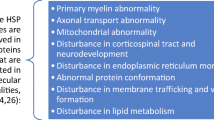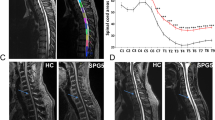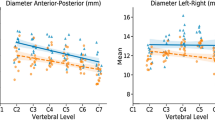Abstract
Hereditary spastic paraplegia (HSP) is a genetically heterogeneous group of neurodegenerative disorders characterized by progressive lower extremity weakness and spasticity. HSP pathology involves axonal degeneration that is most pronounced in the terminal segments of the longest descending (pyramidal) and ascending (dorsal columns) tracts. In this study, we compared spinal cord magnetic resonance imaging (MRI) in 13 HSP patients with four different types of autosomal dominant hereditary spastic paraplegia (SPG3A, SPG4, SPG6, and SPG8) with age-matched control subjects. The cross-section area of HSP subjects at cervical level C2 was 59.42±12.57 mm2 and at thoracic level T9 was 28.58±5.25 mm2. Both of these values were less than in the healthy controls (p<0.001). The degree of cord atrophy was more prominent in patients with SPG6 and SPG8 who had signs of severe cord atrophy (47.60±6.58 mm2 at C2, 21.40±2.4 mm2 at T9) than in subjects with SPG3 and SPG4 (66.0±8.94 mm2 at C2, p<0.02; 31.75±2.76 mm2 at T9, p<0.001). These observations indicate that spinal cord atrophy is a common finding in the four genetic types of HSP. Spinal cord atrophy was more severe in SPG6 and SPG8 HSP subjects than in other types of HSP we studied. This may suggest a different disease mechanism with more prominent axonal degeneration in these two types of HSP when compared with HSP due to spastin and atlastin mutations.

Similar content being viewed by others
References
Fink JK (2002) Hereditary spastic paraplegia. In: Rimoin DL, Pyeritz RE, Connor JM, Korf BR (eds) Emery and Rimoin’s principles and practice of medical genetics, 4th edn. Harcourt, London, pp 3124–3145
Fink JK (2003) The hereditary spastic paraplegias: nine genes and counting. Arch Neurol 60:1045–1049
Fink JK, Heiman-Patterson T, Bird T, Cambi F, Dubé M-P, Figlewicz DA, Haines JL et al (1996) Hereditary spastic paraplegia: advances in genetic research. Neurology 46:1507–1514
Hazan J, Fonknechten N, Mavel D et al (1999) Spastin, a new AAA protein, is altered in the most frequent form of autosomal dominant spastic paraplegia. Nat Genet 23:296–303
Zhao X, Alvarado D, Rainier S et al (2001) Mutations in a novel GTPase cause autosomal dominant hereditary spastic paraplegia. Nat Genet 29:326–331
Hansen JJ, Durr A, Cournu-Rebeix I et al (2002) Hereditary spastic paraplegia SPG13 is associated with a mutation in the gene encoding the mitochondrial chaperonin Hsp60. Am J Hum Genet 70:1328–1332
Reid E, Kloos M, Ashley-Koch A et al (2002) A kinesin heavy chain (KIF5A) mutation in hereditary spastic paraplegia (SPG10). Am J Hum Genet 71:189–194
Rainier S, Chai J-H, Tokarz D, Nicholls RD, Fink JK (2003) NIPA1 gene mutations cause autosomal dominant hereditary spastic paraplegia (SPG6). Am J Hum Genet 273:967–971
Schwarz GA (1952) Hereditary (familial) spastic paraplegia. Arch Neurol Psychiatry 68:655–682
Sack GH, Huether CA, Garg N (1978) Familial spastic paraplegia: clinical and pathological studies in a large kindred. Johns Hopkins Med J 143:117–121
White KD, Ince PG, Lusher M et al (2000) Clinical and pathologic findings in hereditary spastic paraparesis with spastin mutation. Neurology 51:89–94
Dürr A, Brice A, Serdaru M et al (1994) The phenotype of pure autosomal dominant spastic paraplegia. Neurology 44:1274–1277
Krabbe K, Nielsen JE, Fallentin E, Fenger K, Herning M (1997) MRI of autosomal dominant pure spastic paraplegia. Neuroradiology 39:724–727
Nielsen JE, Krabbe K, Jennum P et al (1998) Autosomal dominant pure spastic paraplegia: a clinical, paraclinical and genetic study. J Neurol Neurosurg Psychiatry 64:61–66
Hedera P, DiMauro S, Bonilla E et al (1999) Phenotypic analysis of autosomal dominant hereditary spastic paraplegia linked to chromosome 8q. Neurology 53:44–50
Hedera P, Rainer S, Alvarado D et al (1999) Novel locus for autosomal dominant hereditary spastic paraplegia, on chromosome 8q. Am J Hum Genet 64:563–569
Lathrop GM, Lalouel JM, Julier C, Ott J (1985) Multipoint linkage analysis in humans: detection of linkage and estimation of recombination. Am J Hum Genet 37:482–498
Rauch RA, Jinkins JR (1994) Analysis of cross-sectional area measurements of the corpus callosum adjusted for brain size in male and female subjects from childhood to adulthood. Behav Brain Res 64:65–78
Fink JK, Sharp GB, Lange BM et al (1995) Autosomal dominant, familial spastic paraplegia, type I: clinical and genetic analysis of a large North American family. Neurology 45:325–331
Hentati A, Deng HX, Zhai H et al (2000) Novel mutations in spastin gene and absence of correlation with age at onset of symptoms. Neurology 55:1388–1390
Shibasaki Y, Tanaka H, Iwabuchi K et al (2000) Linkage of autosomal recessive hereditary spastic paraplegia with mental impairment and thin corpus callosum to chromosome 15q13–15. Ann Neurol 48:108–112
Okubo S, Ueda M, Kamiya T, Mizumura S, Terashi A, Katayama Y (2000) Neurological and neuroradiological progression in hereditary spastic paraplegia with a thin corpus callosum. Acta Neurol Scand 102:196–199
Acknowledgements
P.H. is supported by NIH K08NS42743. J.K.F. is supported by NIH R01NS33645, NIH R01NS38713, and the VA Merit Review Award. S.R. is supported by a grant from the University of Michigan Institute of Gerontology.
Author information
Authors and Affiliations
Corresponding author
Rights and permissions
About this article
Cite this article
Hedera, P., Eldevik, O.P., Maly, P. et al. Spinal cord magnetic resonance imaging in autosomal dominant hereditary spastic paraplegia. Neuroradiology 47, 730–734 (2005). https://doi.org/10.1007/s00234-005-1415-3
Received:
Accepted:
Published:
Issue Date:
DOI: https://doi.org/10.1007/s00234-005-1415-3




